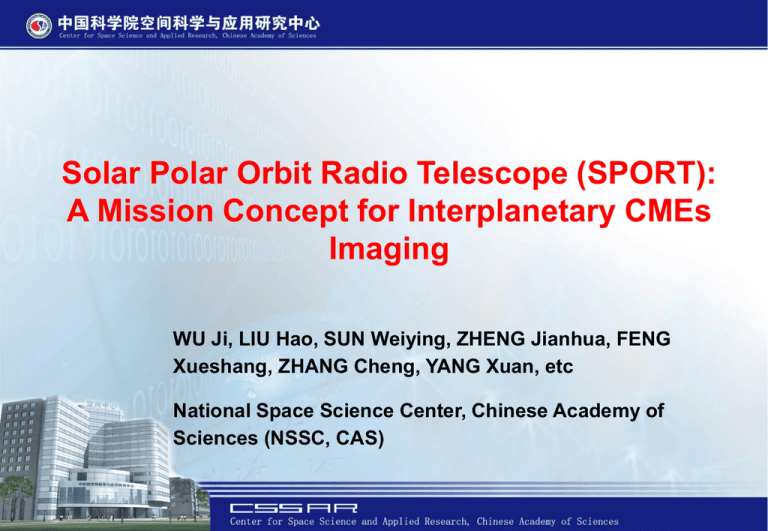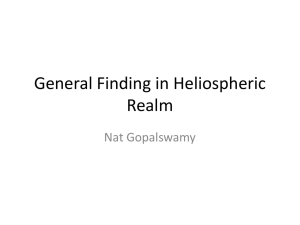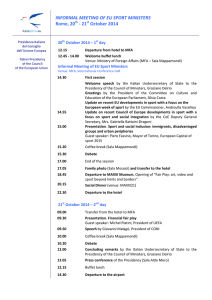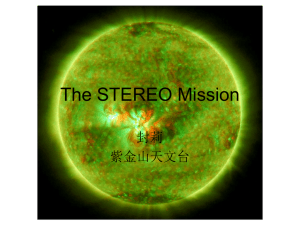PPT
advertisement

Solar Polar Orbit Radio Telescope (SPORT): A Mission Concept for Interplanetary CMEs Imaging WU Ji, LIU Hao, SUN Weiying, ZHENG Jianhua, FENG Xueshang, ZHANG Cheng, YANG Xuan, etc National Space Science Center, Chinese Academy of Sciences (NSSC, CAS) Contents • Background & Motivation − Objective: CME observation − How? Synthetic aperture imaging • Mission Overview − Frequency selection − System design − Orbit design − Other payloads − Current status & development plan • Summary 1. Background Coronal Mass Ejections (CMEs) are expulsions of coronal plasmas and magnetic fields from the Sun. CME The detection of CMEs between the Sun and the Earth is important for understanding and ultimately predicting space weather conditions. CME observations: Ground-based observation Mark IV coronagraph MLSO, Hawaii, Sep.7, 2005 Nancay Radioheliograph CME observations: Spaceborne observation 1.Background Due to the latitude effect and the rotation of the Sun, most of the CME’s are propagate near the ecliptic plane. 1. Background To observe the CME’s from solar polar orbit is expected in order to have an overall view of it and predict the direction of its propagation. SPORT SPORT SPORT Sun Earth 1. Background • In order to observe the ICMEs (plasma clouds), radio frequency band is then proposed with the brightness temperature as the main physical parameter to measure • However, to image at radio frequency need a very large antenna aperture and also to scan it. • We need to select an accepted physical aperture of the antenna by a minimum spatial resolution How can we get required spatial resolution from Solar Polar Orbit at radio frequency? • Synthetic Aperture Imaging Technology Original Scene Its spatial Frequency Domain Representation Synthetic Aperture Radio Telescope • 1980, VLA (Very Large Array) • ALMA Advantage: to get very high angular resolution that can not be achieved by traditional real aperture reflector antenna system due to physical aperture size restriction! Microwave Synthetic Aperture Radiometer: for Earth Observation • from 1980’s, L-band, for soil moisture & ocean salinity obsvation • from 2000~, millimeter wave, 50~56GHz, for geostationary atmospheric sounding Difference between Radio Astronomy & Earth Observation Radio Astronomy Earth Observation Target Field Of View Small Scale Target Distributed Target (several tens degree) Spatial Resolution Arc-seconds Degrees, minutes Sampling requirement in spatial frequency domain Sparse sampling Full sampling SPORT is more like an earth observation system, which is intended for extended targets observation from space. SPORT Overview • System Specifications – – – – – – – Frequency: 150MHz Bandwidth: 20MHz Polarization: Circular Angular Resolution: 2º Radiometric Sensitivity: ~1K Imaging Period: 30~60 mins FOV: ±25º SPORT SPORT SPORT Sun Earth Observing Geometry 2.1 Frequency selection Interplanetary CMEs may exhibit three relevant radio emission mechanisms: bremsstrahlung, gyrosynchrotron emission and plasma emission. Bremsstrahlung is produced by Coulomb collisions between charged particles in plasmas. Gyrosynchrotron emission is the electromagnetic emission generated by mildly relativistic electrons moving in a magnetic field. Plasma emission is generated by plasma instabilities, wavewave and/or wave-particle interactions. 2.1 Frequency selection Thermal free-free emission: 2.1 Frequency selection 0.12 140 f=70MHz f=90MHz f=110MHz f=130MHz f=150MHz f=170MHz emission brightness temperature(K) 0.1 0.08 0.06 0.04 0.02 0 0.2 f=70MHz f=90MHz f=110MHz f=130MHz f=150MHz f=170MHz 120 emission brightness temperature(K) (a) 100 80 60 40 20 0.25 0.3 R 0.35 Background solar wind 0.4 0 0.2 0.25 0.3 R 0.35 With Interplanetary CMEs 0.4 2.1 Frequency selection Background brightness temperature 2.1 Frequency selection Background brightness temperature 2.2 System design • Using the clock scan scheme, the main telescope will have two groups of element antennas and their receiving channels, each composed of four elements • Clock Scan can realize uniform sampling of the spatial frequency domain SPORT Artistic View Stowed Dimension of the “seconds boom” group: 35.76m Dimension of the “minutes boom” group: 31.76m Deployed 2.2 System design Front-end Antenna Digital Correlator I 0 ~ 10 MHz Q 0 ~ 10 MHz Central Unit IQ Mixer ADC 140±10MHz LNA PMS (Power Measurement System) Element Antenna/Receiver Power Divider LO(f=140MHz) • Antennas: to receive the of radio emissions of the CME & galactic background • Receivers: to amplify the received noise IQ down-conversion • Digital Correlators: to get the visibilities • PMS: total power measurement • LO & Power Divider: to provide a common LO 2.2 System design 2.2 System design 2.2 System design Antenna: “Umbrella” Deployment 2.2 System design 2.2 System design – imaging simulation Case 1: Case 2: 2.3 Orbit design The orbit of SPORT is designed to follow the Ulysses orbit with a swing by Jupiter to get enough energy to escape from the ecliptic plane: 2.3 Orbit design 2AU 2.3 Orbit design 2.4 Other payloads • Optical instruments: – such as chronographer, X-EUV imagers, Heliospheric Imager, etc • In situ measurement package: – solar wind plasma detectors, both ion and electrons, energetic particle detector, fluxgate magnetometer, low frequency wave detector, solar radio burst spectrometer 2.4 Current study and development Schedule The concept of SPORT was proposed in 2004. Enhanced key technology and engineering feasibility studies 2008-2011,with the support from CNSA. Frequency issues, sensitivity v.s. background Main telescope (element channels)design and ground test Image retrieval algorithms Orbit injection studies ICMEs propagation numerical simulation and theories 2.4 Current study and development Schedule • Background engineering study (ongoing): 2011~2015, with the support from “Strategic Priority Research Program - Space Science” of the CAS • Engineering development may start 2016 • Launch date: March 2020 • In orbit observation start 2023-2024 Summary SPORT will be probabaly the first mission taking image of the interplanetary CME from the solar polar orbit (>38 degrees) It will provide unique overall view of the interplanetary CME not only on the Sun – Earth line but all around using radio frequency band and optical instruments International participation is welcome Thank You








